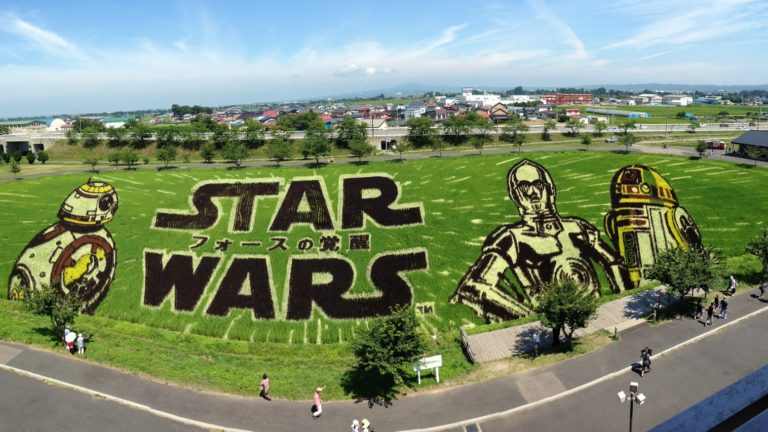In the Japanese village of Inakadate, intricate designs are created on rice paddy fields by intermixing several different kinds of rice plants of varying color. The result is astounding large scale artworks that last all through the growing season until the time of harvest. This is known as Tanbo, or rice-paddy art. Over a thousand volunteers, mostly local ones, come together each year to help with the planting process.
These remarkable artworks are representations of traditional Japanese icons and figures, and legends, anime characters as well as some other classical art pieces like Mona Lisa, and historical figures like Napoleon and Marilyn Monroe can be recognized. To admire these rice fields art, a 22 m-high mock castle tower was erected at the village office and serves as a viewing platform for the hundreds of thousands of visitors coming from all across Japan. In 2006, the village had welcomed more than 200 000 visitors.

Fujin (the god of wind) and Raijin (the god of thunder) paintings were made with the catch phrase ‘Let’s blow the economic depression away!’.These are originally from the famous painter Ogata Kōrin

One of the most famous scenes in Japanese history: the fight between Benkei and Ushiwaka-maru

On the left: Kaguya Hime, the Moon Princess, returning to her people at the end of “The Tale of the Bamboo Cutter”. On the right: The Bamboo Cutter and his wife at the glowing section of bamboo, where the princess arrived to the Earth as a baby
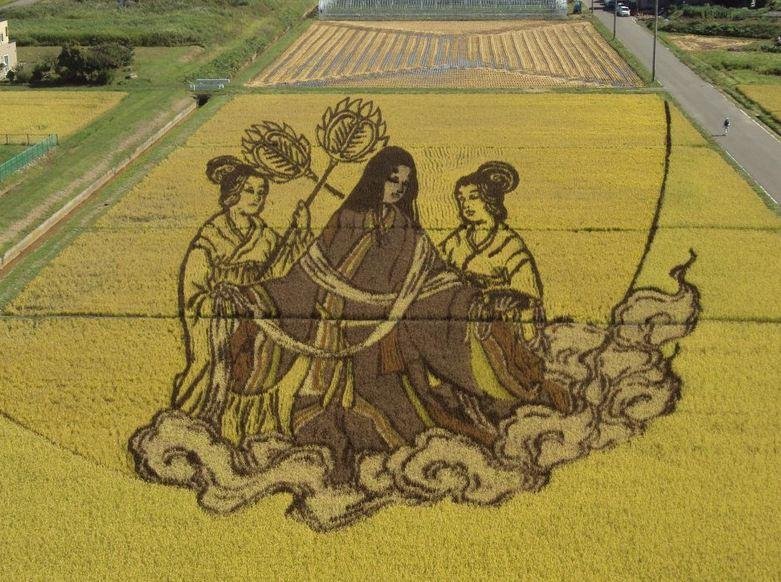


Credit: 掬茶 / Wikimedia commons
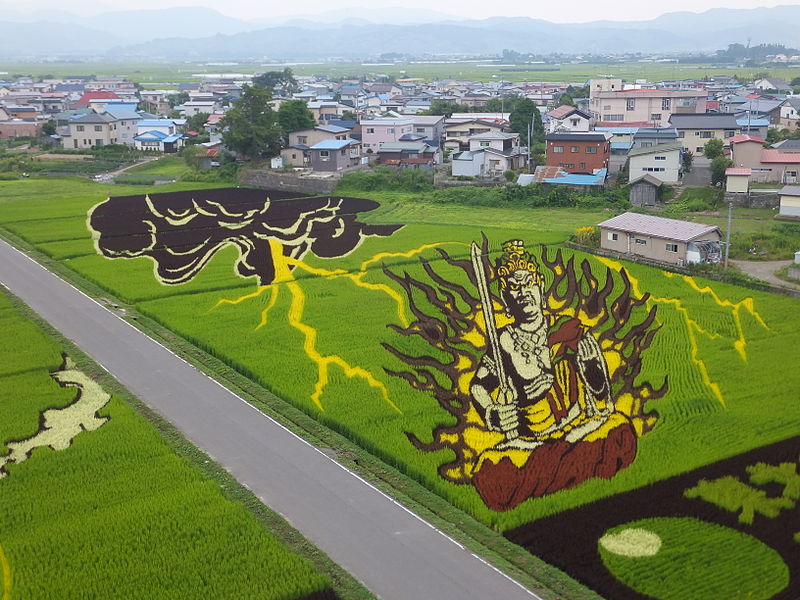
Credit: 掬茶 / Wikimedia commons



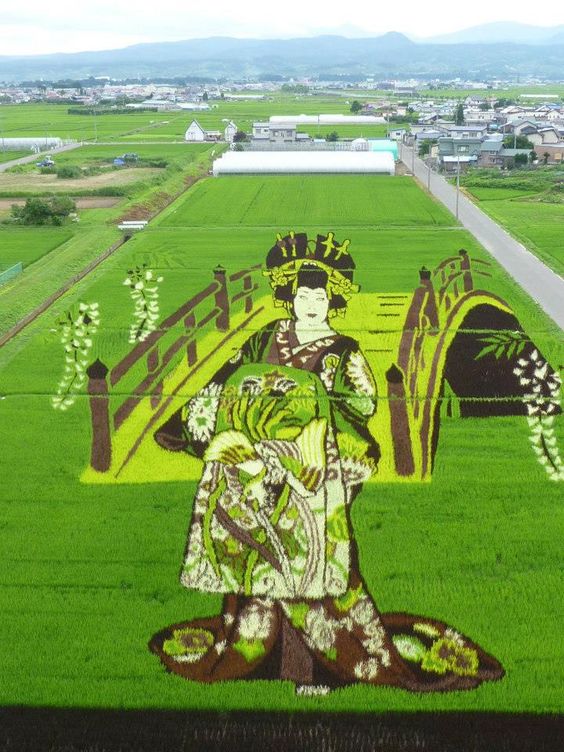
Rice field art has spread all across the country and currently, there are more than 100 rice field art locations throughout Japan. However, it is said that the art in Inakadate village, where this art form originated, is more refined in its image quality and considered as the most beautiful in Japan.
It can be hard to believe that these art works are only made by rice plants due to their vivid and colorful nature. One of the highlights of this art is that the rice plants are never cut or colored, but these are indeed their natural color that adds to the definition and feature of the pictures.

Credit: Glenn Waters

Credit: Captain76 / Wikipedia

Credit: samuraidave / imgur

Courtesy of Inakadate village
Kodaimai rice, which has purple and yellow leaves, is planted among green-leaved tsugaru roman rice to create the patterns. The main rice used for the background is an everyday variety called asayuki, plus three heirloom varieties and six genetically modified strains. Although the heirloom and GMO strains are edible, they may not suit modern tastes. However, it is suggested that if made into ohagi, it has a sticky consistency similar to mochi and is actually nice.
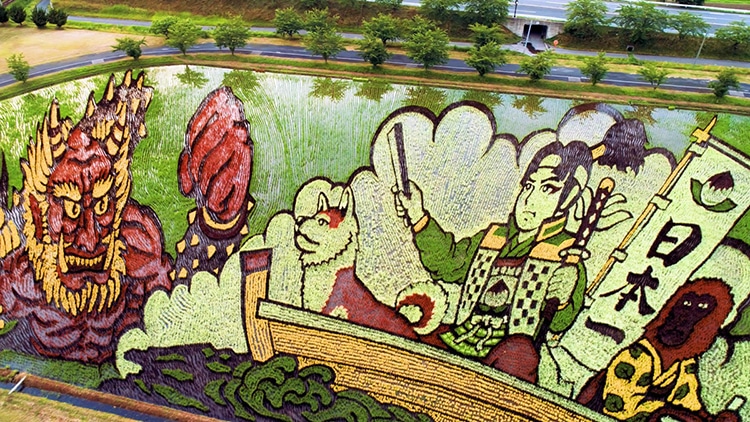
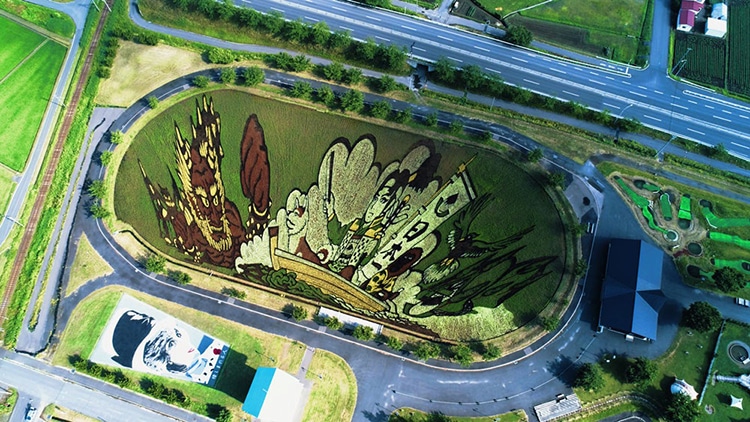


Credit: thenikku
It all began in 1993, at a time when the village of Inakadate was suffering from a shrinking population, a crushing debt and declining revenues from agriculture. The village was only a rice farming area with nothing special to see and didn’t attract any tourists. Findings from an archaeological exploration in 1981 revealed that rice had been grown in the area for more than 2000 years, making Inakadate one of the oldest rice-growing regions in northern Japan. As a way to revitalize their village, the inhabitants of Inakadate came up with this novel idea to promote tourism in their locality: large-scale rice paddy art.

Credit: Viki Pandit



Credit: Courtesy of Inakadate village
At that time, elementary-school students were planting heirloom purple and yellow rice, and green everyday rice, in a striped pattern. On seeing this, the person in charge at town hall wondered if rice could be planted in a way to represent words and pictures. And so, Tanbo, or rice-paddy art, was born.
Back then, it was an ordinary design – a simple triangular shape to represent Mount Iwaki, planted by a few hundred villagers. It gained a modest success and attracted only a few spectators. Over the years, the designs have developed into more elaborate and imaginative ones, and now, hundreds of thousands of tourists visit every year to admire these incredible masterpieces.

Credit: The Asahi Shimbun / Getty images


Credit: ChrisSteph & Lewis Boegeman

Every April, the village council gathers to discuss and plan the theme of the design for the next year. After the theme has been agreed on, the village officials first create a basic digital mock-up, which is then refined by local art teachers into intricate concept drawings, while taking into consideration gradation and perspective.
A computer image-processing software is used to determine where and how to plant such a complex design. The original image can be a photograph or a detailed graphic and may use hundreds or thousands of colors, but all of this is reduced to around seven colors of farm field rice. Markers are then placed, mapping out each drawing before the planting begins with the participation of over a thousand dedicated volunteers. This whole process can take up to three months. By looking at the history of the art, consequent improvement about the designs can be seen with each passing year, as the villagers learn from their past mistakes and refine their craft.
This is what rice field art looks like (design of 2019) when still in the process of growing:

After the rice plants have reached their full growth:

Volunteers participating in the planting process, among which students:



Read more articles:
- Silent Killers of the Sea: Fishing Nets and the Devastating Impact on Our Oceans
- Amazing Ability of Sharks to Regrow Their Dorsal Fins
- Mountain Marvels: 7 Architectural Wonders Built into Nature’s Slopes
- The Frilled Shark: Jaws of the Abyss and a Living Fossil
- 30 Christmas Rock Painting Ideas – Last minute DIY crafts for Christmas decor, gifts and stocking fillers

